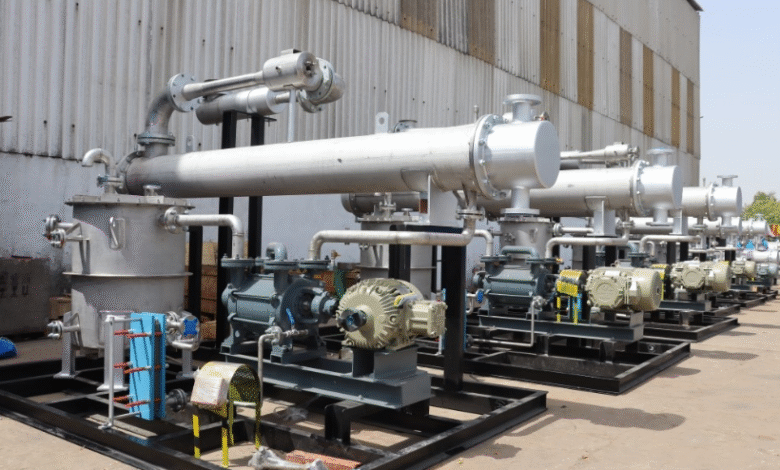Vacuum Ejector Pump: How It Works and Where It Is Used

A vacuum ejector pump is a compact yet powerful device that creates a vacuum using compressed air instead of mechanical components. This technology is widely used in industries where clean, efficient, and maintenance-free vacuum generation is essential. In this article, we’ll explain how a vacuum ejector pump works, explore its core mechanism, and discuss the various industries and applications where it plays a crucial role in improving productivity and automation efficiency.
What Is a Vacuum Ejector Pump?
A vacuum ejector pump (also called a jet pump or Venturi pump) is a device that creates a vacuum by lowering the pressure below the surrounding air. It works without any moving parts, using the energy of a fast-moving fluid (like compressed air or steam) to draw air or gas from a system.
Major Components
- Nozzle – The nozzle is where the driving fluid (like compressed air, steam, or liquid) enters the ejector. It speeds up the fluid, which lowers its pressure and creates a suction that pulls in gas or air from the suction port. The nozzle’s design is important because it affects how strong and efficient the vacuum is.
- Diffuser – After the fluid mixes with the suctioned gas, it moves into the diffuser, a widening section of the ejector. Here, the fast-moving mixture slows down, turning speed into pressure so it can be safely discharged. The diffuser also helps guide the flow smoothly.
- Suction Port – This is where the gas or air to be removed enters the ejector. The low pressure created by the nozzle pulls the gas in. The size and position of the suction port affect how well the ejector works.
- Mixing Chamber – In this section, the driving fluid and the suctioned gas mix. The momentum of the fast fluid carries the suctioned gas through the ejector, ensuring a steady vacuum and smooth flow out of the system.
These four parts work together to create a vacuum without any moving parts. The design and size of each part influence the ejector’s efficiency, maximum vacuum, and flow capacity.
How a Vacuum Ejector Pump Works
A vacuum ejector pump generates a vacuum using the energy of a fast-moving fluid (typically compressed air or steam) instead of mechanical moving parts. Here’s how it works step by step:
- Driving Fluid Enters the Nozzle – Compressed fluid (like air, steam, or liquid) is pushed through a nozzle. The nozzle speeds up the fluid and lowers its pressure, creating a suction effect.
- Suction Drawn In – The low-pressure zone created by the nozzle pulls air or gas from the suction port into the pump. This is how the vacuum is formed.
- Mixing Chamber – The suctioned gas mixes with the fast-moving driving fluid. This combined flow is carried through the ejector smoothly.
- Diffuser Expels the Mixture – The mixture enters the diffuser, where it slows down. This converts the fluid’s speed back into pressure, allowing it to be safely discharged from the ejector.
There are no moving parts. The vacuum is created entirely by the flow of the driving fluid, making the system simple, reliable, and low-maintenance.
Types of Vacuum Ejector Pumps
Vacuum ejector pumps are widely used in industry to generate a vacuum efficiently without moving parts. The two most common types are air ejectors and steam ejectors, each suited for specific applications.
1. Air Ejectors
Devices that use compressed air to create a vacuum. The air is forced through a nozzle, which speeds it up and lowers the pressure, pulling in air or gas from the system. They are easy to use and work quickly.
- How It Works: Compressed air passes through a nozzle, lowering pressure and drawing in ambient air or gas. The mixture then exits through a diffuser at or near atmospheric pressure.
- Benefits: Simple design, fast response, compact, and lightweight.
- Applications: Packaging machines, robotic pick-and-place systems, laboratory equipment.
2. Steam Ejectors
Devices that use high-pressure steam to create a vacuum. The steam is accelerated through a nozzle, producing a low-pressure zone that draws in air or gas. They are ideal for high-temperature or harsh industrial environments.
- How It Works: Steam expands through a nozzle, entrains gases or vapors, and passes through a diffuser, where pressure rises and the mixture is discharged.
- Benefits: High temperature resistance, robust and durable, with no moving parts.
- Applications: Chemical plants, power generation condensers, and petrochemical industries.
These two types are widely used due to their reliability and suitability for different industrial environments.
See also: Technofies: Shaping the Future of Education and Technology
Applications and Industries
Vacuum ejector pumps are flexible and widely used in industries that need a reliable vacuum. Their simplicity, durability, and lack of moving parts make them suitable for a broad range of applications.
Applications
- Vacuum Packaging – Sealing food, pharmaceuticals, and consumer goods.
- Vacuum Forming – Shaping plastics in packaging and manufacturing.
- Chemical Processing – Distillation, evaporation, drying, and degassing.
- Power Generation – Maintaining a vacuum in steam turbine condensers to improve efficiency.
- Laboratory and Research – Providing a clean, oil-free vacuum for experiments and testing.
- Robotics and Automation – Pick-and-place systems for handling components in electronics, food, and medical industries.
- Water Treatment and Evaporation – Creating a vacuum in desalination and evaporation processes.
Industries
- Food and Beverage – Packaging, drying, and degassing processes.
- Pharmaceuticals – Tablet drying, vacuum filtration, and sterile packaging.
- Chemical and Petrochemical – Vacuum distillation, evaporators, and chemical reactors.
- Power Generation – Maintaining condenser vacuum in thermal power plants.
- Electronics and Semiconductor – Handling delicate components in manufacturing lines.
- Plastic and Packaging – Vacuum forming and sealing operations.
- Laboratories and Research Facilities – Experiments requiring controlled vacuum conditions.
Vacuum ejector pumps are used in these applications because they are reliable, easy to maintain, compact, and can work well in hot or harsh conditions.
Advantages of Vacuum Ejector Pumps
1. Fast Response
Vacuum ejector pumps can quickly create vacuum conditions due to the immediate action of the motive fluid (compressed air, steam, or water). This makes them ideal for applications requiring rapid vacuum buildup and frequent cycling, such as packaging machines, laboratory experiments, and robotic pick-and-place systems. The fast response ensures minimal downtime and high process efficiency.
2. Maintenance-Free Operation
Since vacuum ejectors have no moving parts, they are inherently low-maintenance. There is no mechanical wear, no lubrication required, and fewer components that could fail. This lowers costs, boosts reliability, and enables continuous industrial operation with minimal maintenance.
3. Compact and Robust Design
Vacuum ejectors are small, lightweight, and robust, which allows easy installation in tight spaces or integration into complex systems. Despite their compact size, they are durable and capable of handling continuous operation under industrial conditions. This design lets them be used in many places, from small labs to big factories.
4. Suitable for Harsh Environments
Certain types of ejectors, especially steam ejectors, can operate under high temperatures and with corrosive gases or vapors. This makes them perfect for demanding industries like chemical plants, petrochemical facilities, and power plants.




